Blog
Cloud Phone System
What is an Outbound Call Center? Everything SMBs and Startups Need to Know

What is an Outbound Call Center? Everything SMBs and Startups Need to Know
Learn what an outbound call center is, why it’s important for businesses, and how outbound call center services and software help them operate efficiently.
Many businesses immediately see the value of an inbound call center, but when it comes to outbound call centers, questions often arise: do we really need one? The truth is, outbound call centers play a crucial role in driving sales and lead generation, supporting marketing campaigns, gathering customer feedback and data, ensuring quality, and proactively resolving complaints.
Traditionally, running an outbound call center might conjure images of a full office of agents constantly dialing phone numbers — a setup that can feel costly and complex, especially for small businesses and startups. But with the right outbound call center software, which offers advanced technology, it’s possible to streamline calls, automate workflows, and achieve business goals without significant upfront investments.
In this article, we’ll explore what an outbound call center is, why it matters for businesses, the challenges they may encounter, and how modern technology is enhancing the way outbound call centers operate.
What is an Outbound Call Center?
An outbound call center is a business operation that can function as a standalone department or as part of a larger contact center, where agents proactively make outgoing calls to customers or prospects. While it’s often associated with cold sales and lead generation, outbound calling also includes informing existing customers about offers and promotions, following up for quality assurance, sending reminders, and collecting data through surveys. In short, the main purpose of an outbound call center is to proactively engage with both potential and existing customers.
Some contact centers focus exclusively on outbound calls, while others handle only incoming calls. It’s also possible to combine both outbound and inbound operations within a single center.
Outbound Call Center vs Outbound Contact Center
Although the terms “outbound call center” and “outbound contact center” are often used interchangeably, there’s an important distinction: outbound call centers focus solely on phone communication, while outbound contact centers engage with customers across multiple channels, including phone calls, emails, live chat, and messaging apps.
Today, as customer interactions take place across multiple channels, outbound call centers are adapting to this new reality by expanding their reach, connecting with customers through text messages, emails, messaging apps, or social media. In this context, an outbound call center can also be referred to as an “outbound contact center.”
Types of Outbound Call Centers
As we’ve seen, outbound call centers can serve a variety of business goals, depending on the type of calls being made and the desired outcomes. Here’s a breakdown of the main types:
Sales-Focused Outbound Call Centers
These are the most well-known type. An outbound sales call center contacts potential customers in the sales pipeline to close deals or reach existing customers for upselling and cross-selling, helping businesses increase revenue by promoting additional products or services.
Lead Generation Outbound Call Centers
The second most common type, closely related to sales, focuses on leads in the early stages of the sales pipeline or even cold leads. The goal is to capture customer interest and move prospects further down the sales funnel.
Proactive Customer Service and Support Outbound Call Centers
These centers reach out to customers to resolve issues before they escalate, provide product updates, send reminders, or follow up after a service interaction, improving customer satisfaction and loyalty.
Quality Assurance Outbound Call Centers
Focused on customer feedback, these centers follow up to measure satisfaction with a product or service, gather data, and take action if a customer raises concerns.
Market Research and Survey Outbound Call Centers
Specializing in data collection, these centers conduct surveys and research to gather insights, measure customer sentiment, and inform business decisions.
Collections and Debt Recovery Outbound Call Centers
These centers contact customers with overdue accounts, negotiate payments, and help businesses recover outstanding debts.
What Is Difference Between Inbound and Outbound Call Center?
While inbound and outbound call centers serve opposite functions, they can also be combined to maximize the ultimate business goals: customer satisfaction and business growth. Let’s take a closer look at how they compare:
- Inbound call centers: Inbound call centers handle incoming calls from customers. Agents respond to inquiries, provide support, assist with orders, or manage account-related requests. The goal is to help customers efficiently by resolving issues, answering questions, and processing requests.
- Outbound call centers: Outbound call centers focus on making outgoing calls to customers or prospects. Agents initiate contact to promote offers, conduct surveys, follow up on interactions, or generate leads. Outbound calling is proactive, aiming to drive business objectives such as sales growth, engagement, or information gathering.
The fundamental difference is who initiates the call: inbound calls are customer-initiated, while outbound calls are company-initiated. This distinction also shapes the skills agents need. Inbound agents excel at problem-solving and delivering excellent customer service, while outbound agents thrive on persuasion, resilience, and engaging people who may not expect to be contacted.
Some organizations use blended or hybrid call centers, where agents handle both inbound and outbound calls. For example, a small business agent might take inbound support calls during part of the day and make outbound sales or follow-up calls during another, maximizing efficiency and flexibility.
How Does Outbound Call Center Work?
Running an outbound call center can be broken down into a straightforward process:
- Set the objective of the outbound call center: Decide the purpose of your outbound calls, whether it’s generating sales, following up with customers, collecting feedback, or conducting surveys. A clear goal guides every action in the process.
- Prepare the contact list: Build a targeted list of contacts for each purpose, including existing customers, leads in your pipeline, or potential prospects. Ensure the list contains all the necessary information agents need to make calls effectively and handle conversations successfully.
- Prepare training and materials for agents: Provide agents with the tools they need to perform effectively. This includes call scripts, email templates, and scenario guidelines. These materials ensure consistent messaging, help agents handle customer objectives professionally, and maintain a persuasive approach.
Once the goals of your outbound call center are set, agents can begin the next steps:
- Initiate outbound communication: Agents proactively reach out to contacts via phone, email, SMS, or messaging apps. Modern outbound contact centers use software to automate dialing, schedule follow-ups, and track every interaction.
- Log and monitor results: Agents record each interaction in your CRM or customer support system, noting outcomes such as sales, completed surveys, or resolved issues. This data helps refine strategies and improve overall performance over time.
- Follow up and take action: Based on the results, agents follow up on promising leads, escalate customer concerns, or hand qualified prospects to the sales team.
In short, an outbound call center works as a continuous cycle of planning, contacting, tracking, acting, measuring, and refining. This ongoing process ensures the call center not only meets business objectives like increasing sales, generating leads, or improving customer satisfaction, but also evolves over time to become more efficient and effective.
The Importance of Outbound Call Centers for Small Business
It might seem that outbound call centers are only useful for large organizations with entire departments dedicated to continuous customer outreach. That’s not entirely true. Small businesses and startups can also gain significant value, especially when leveraging the right outbound call center software solution. Even small teams can proactively engage customers and drive sales growth.
Here are some key ways outbound call centers make an impact:
- Drive revenue: Outbound call centers allow small businesses to actively reach out to prospects and existing customers, promoting products, upselling, and cross-selling. For example, a local software startup can contact trial users to offer premium features, or a boutique online store can follow up with recent customers to recommend complementary items. By initiating targeted conversations, businesses can create more sales opportunities and accelerate revenue growth without waiting for customers to come to them.
- Proactive feedback and data collection: Reaching out to customers through surveys, follow-ups, or check-ins enables small businesses to gather valuable insights. For instance, a small e-commerce store could contact customers after a recent purchase to collect feedback on their shopping experience or product satisfaction, or a SaaS company might survey users to understand which features are most valuable. This data helps businesses identify pain points and refine offerings, giving them a competitive edge without relying on passive feedback.
- Quality assurance: Customer satisfaction is critical for businesses in every industry. Outbound calls can help ensure satisfaction and maintain high service quality. A small beauty salon might follow up with clients after an appointment to ensure they were happy with their service, or a local service provider could check in after a consultation to confirm expectations were met. These calls help quickly resolve issues, prevent complaints from escalating, and strengthen customer trust and loyalty.
Outbound Call Center Key Performance Metrics (KPIs)
Measuring the success of an outbound call center requires tracking specific performance metrics that reflect productivity, efficiency, and business impact. Here are the key KPIs every outbound operation should monitor:
- Calls per agent (calls per hour): This metric measures the number of calls an agent makes within an hour. It helps assess individual productivity and ensures that call volumes are sufficient to meet campaign goals. Monitoring calls per agent also helps in staffing decisions and balancing workloads.
- Contact rate (answer success rate): The contact rate tracks the percentage of calls where an agent successfully reaches a live person. A higher contact rate indicates effective lead targeting and accurate contact lists.
Benchmark: Typically, 10–30% for cold outreach campaigns.
- Conversion rate: Conversion rate measures the percentage of calls that achieve the desired outcome, such as a sale, booked appointment, or completed survey. It reflects the effectiveness of agents and scripts in achieving business objectives.
Benchmark: 5–15% depending on industry.
- Average handle time: AHT tracks the average duration of an outbound call, including both talk time and any follow-up or administrative work.
- Average cost per lead: ACPL measures the investment required to generate a single lead, accounting for software, staffing, and operational costs. Tracking this metric ensures that outbound campaigns remain cost-effective.
Benchmark: Varies by industry.
- Average revenue per lead: ARPL calculates the average revenue generated from each lead. This helps evaluate the financial impact of outbound efforts.
Benchmark: Varies by industry but should ideally be at least 2x the cost per lead.
7. Bounce rate: This metric shows the percentage of calls that fail due to disconnected numbers, wrong numbers, or unavailable contacts. A high bounce rate may indicate outdated or inaccurate contact lists and highlights the need for data hygiene and list verification.
By monitoring these KPIs, businesses can optimize outbound call center operations, improve agent performance, and ensure that campaigns are both effective and cost-efficient.
Common Challenges in Outbound Call Centers (and How to Overcome Them)
Running outbound call campaigns can be highly effective, but it comes with challenges, especially for small businesses that are new to this type of outreach. Understanding the common hurdles and strategies to overcome them can make your campaigns more successful.
Low Answer/Connection Rates
A frequent frustration is when agents make calls, but few prospects pick up. This can happen due to calling at inconvenient times, prospects screening unknown numbers, or numbers being flagged as spam.
Solution: Experiment with different call times to reach prospects when they are most likely available. Use a local presence phone number or rotate caller IDs to avoid being blocked or marked as spam. Ensure your number is registered as a legitimate business to prevent labels like “Scam Likely.” Also, keep contact lists clean by removing outdated or invalid numbers.
High Call Rejection Rates
Cold calls or unsolicited calls can be perceived as intrusive, leading to high rejection rates.
Solution: Personalize and target calls carefully to ensure they are relevant to the recipient. Tailoring your message and demonstrating value upfront makes prospects more receptive to the conversation.
Agent Burnout and Turnover
Outbound calling can be repetitive and stressful, especially in small teams where a few individuals may be responsible for the majority of calls, leading to fatigue.
Solution: Rotate tasks to break up long calling sessions. For example, an agent might spend two hours calling, then switch to administrative tasks or follow-ups. Encourage regular breaks and avoid overloading call lists. Recognize and appreciate agents’ efforts to increase morale and reduce turnover.
Prospect Frustration or Complaints
Some prospects may dislike telemarketing calls and respond negatively or lodge complaints.
Solution: Target the right audience to minimize irrelevant calls. Train agents to be respectful and transparent: clearly identify the business and reason for calling at the start of each conversation. If a prospect is not interested, end the call politely and remove them from future contact lists. Agents should also be trained in de-escalation techniques, such as apologizing for any inconvenience, ending the call calmly, and avoid arguing. Maintain records of “do not call” requests to ensure compliance.
Outbound Call Center Services and Solutions
Skilled agents are the heart of any outbound call center, but running an effective operation, whether in-house or through an external service, also requires the right tools, software, and technology solutions.
A reliable outbound call center software simplifies operations by managing technical aspects, automating workflows, and allowing agents to focus on what matters most: connecting with customers instead of repetitive administrative work.
Choosing the right software is critical, whether you’re building an outbound call center from scratch or looking for a more advanced solution to optimize your existing operations.
Let’s explore the key features that outbound call center solutions typically offer:
Auto Dialer Tools
Many software solutions come with different types of auto dialers for outbound call centers, each designed to effectively connect agents with customers.
Predictive Dialer
- How it works: Uses algorithms to dial multiple numbers simultaneously and predicts when agents will be available to take the next call.
- Key benefit: Minimizes idle time for agents.
- Best for: High-volume campaigns, such as sales, telemarketing, or collections.
Power Dialer
- How it works: Automatically dials numbers from a contact list one after another, moving to the next as soon as a call ends or goes unanswered.
- Key benefit: Speeds up dialing without overwhelming agents.
- Best for: Moderate-volume campaigns where agents can handle calls sequentially.
Preview Dialer
- How it works: Shows the agent information about the contact before placing the call, allowing them to review notes or past interactions.
- Key benefit: Enables personalized and informed conversations.
- Best for: High-value prospects or complex sales processes requiring context before the call.
Progressive Dialer
- How it works: Automatically dials one number at a time per available agent, dialing the next only when the agent is ready.
- Key benefit: Reduces downtime while maintaining control over each call.
- Best for: Campaigns needing a balance between automation and agent control.
Local Phone Numbers
Using local phone numbers helps your calls feel familiar and trustworthy to recipients. Customers are more likely to answer a call that appears to come from their city or region, rather than an unknown or toll-free number. For example, a business based in New York calling prospects in Los Angeles could use a Los Angeles area code, increasing the likelihood that recipients pick up.
CHOOSE_PHONE_NUMBER
Customizable Caller ID
Whether a call from your outbound call center looks like just another spam call or appears as a recognizable business name can make all the difference in whether the recipient picks up. By customizing your business caller ID, you help customers instantly recognize you, reduce call rejection rates, and reinforce brand credibility.
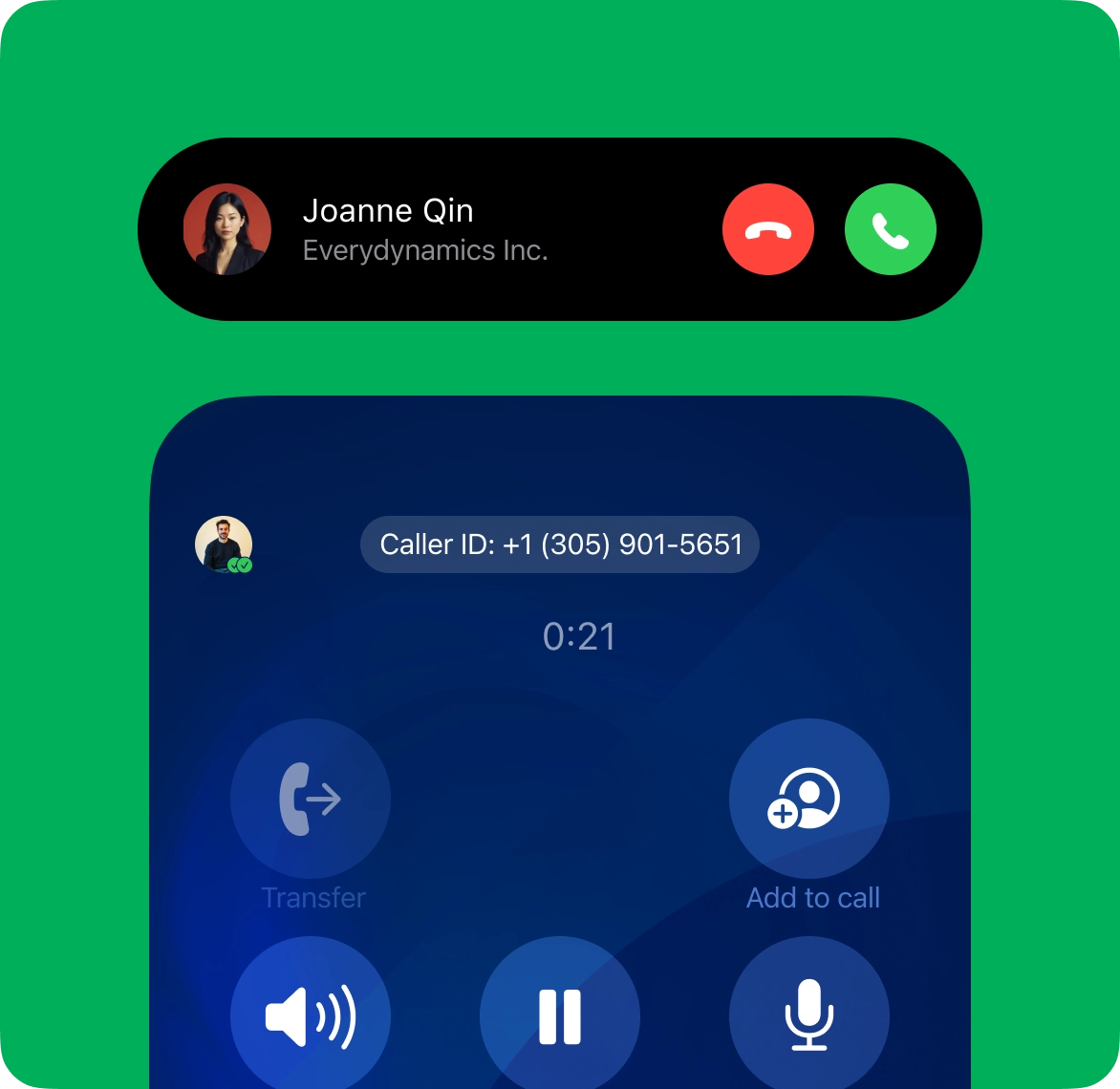
Call Recordings
Recording outbound calls offers multiple advantages. It ensures quality assurance by allowing managers to review agent interactions and ensure adherence to company scripts and compliance standards. It also provides training opportunities, letting new agents learn from real calls and improving overall team performance.
Additionally, call recordings serve as a record for resolving disputes, verifying commitments, or analyzing patterns to optimize call strategies. For example, reviewing calls can reveal common objections in sales, helping refine scripts and improve conversion rates.
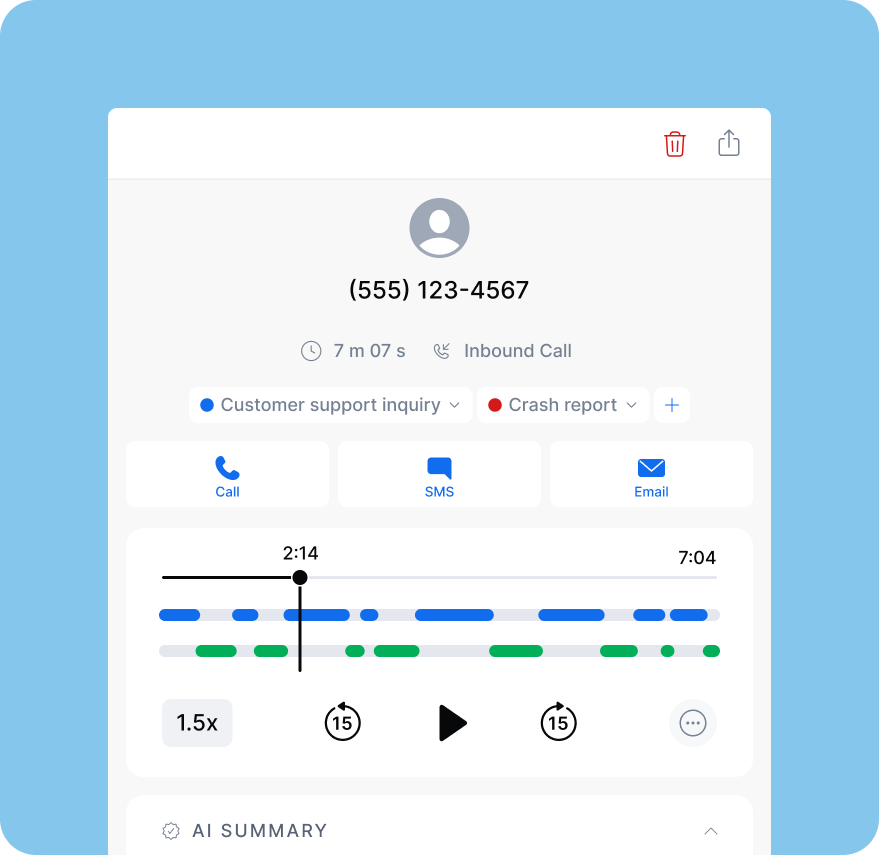
CRM Integrations with Click-to-Call
Many outbound call center solutions integrate seamlessly with CRMs like HubSpot, Salesforce, or Pipedrive, giving agents instant access to customer details, history, and notes. With click-to-call functionality, agents can place calls with a single click, eliminating manual dialing and saving valuable time.
Most integrations offer bi-directional sync, so all call details, such as call duration, outcome, and notes, are automatically logged back into the CRM. This ensures that every conversation is informed, personalized, and accurately recorded, enabling better follow-ups and keeping your CRM data up to date.
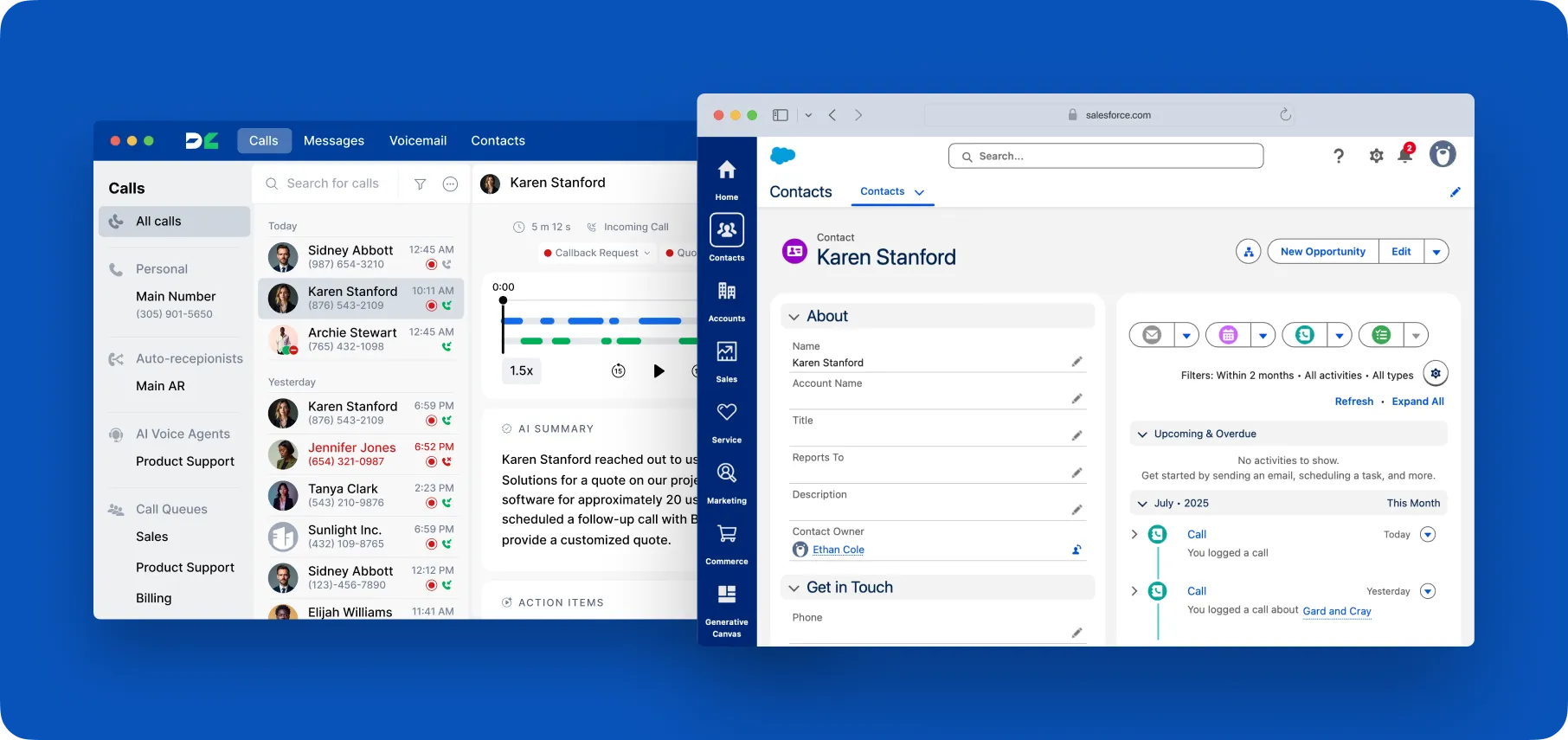
Beyond Traditional Calling: AI Outbound Contact Center
While the features mentioned are enough to launch your outbound call center and start seeing results, many modern outbound call center platforms offer advanced capabilities designed to maximize performance and further automate operations.
AI Voice Agents
Free your human agents from routine outbound tasks by letting AI voice agents handle calls such as appointment confirmations, support follow-ups, feedback collection, and lead qualification ,all while providing natural, human-like interactions.
DialLink’s AI voice agents are fully integrated into the phone system, so small businesses and startups can start using them immediately without the need to hire developers or spend extra time on setup.
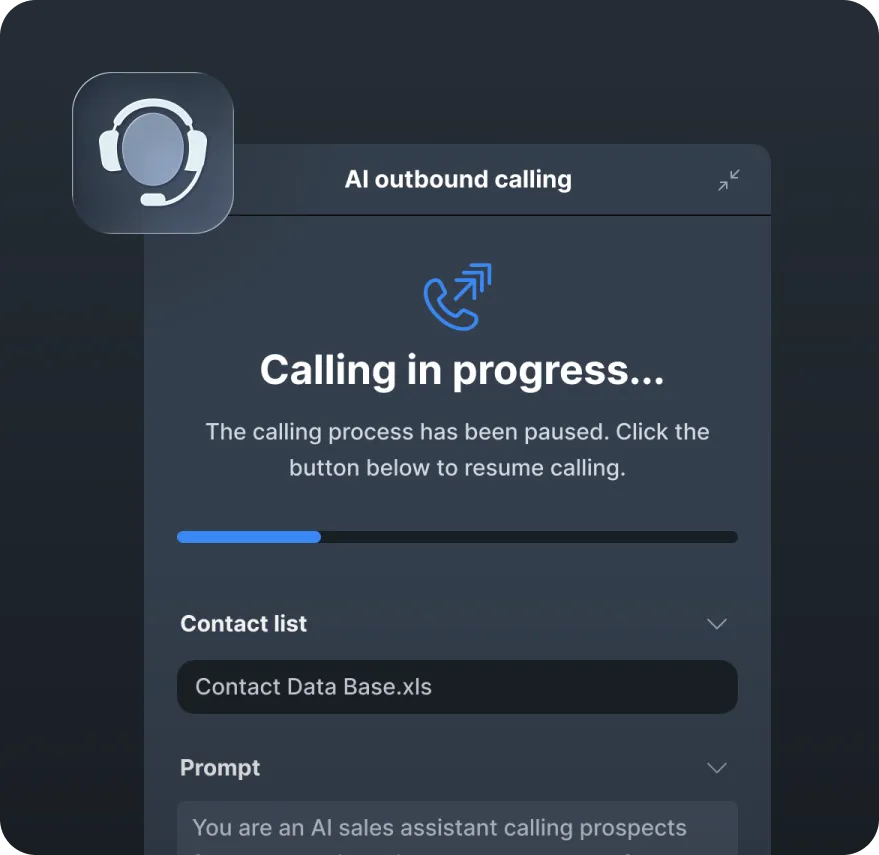
AI Knowledge Bases
Just like your top human agents, AI voice agents need training and guidance. DialLink’s built-in knowledge bases allow you to tailor your AI voice assistant for specific roles, such as outbound sales, lead generation, quality assurance, or customer surveys. By providing access to the right information and guidelines, your AI agents can deliver accurate messaging and ask role-specific questions, ensuring consistent and effective interactions with every customer.
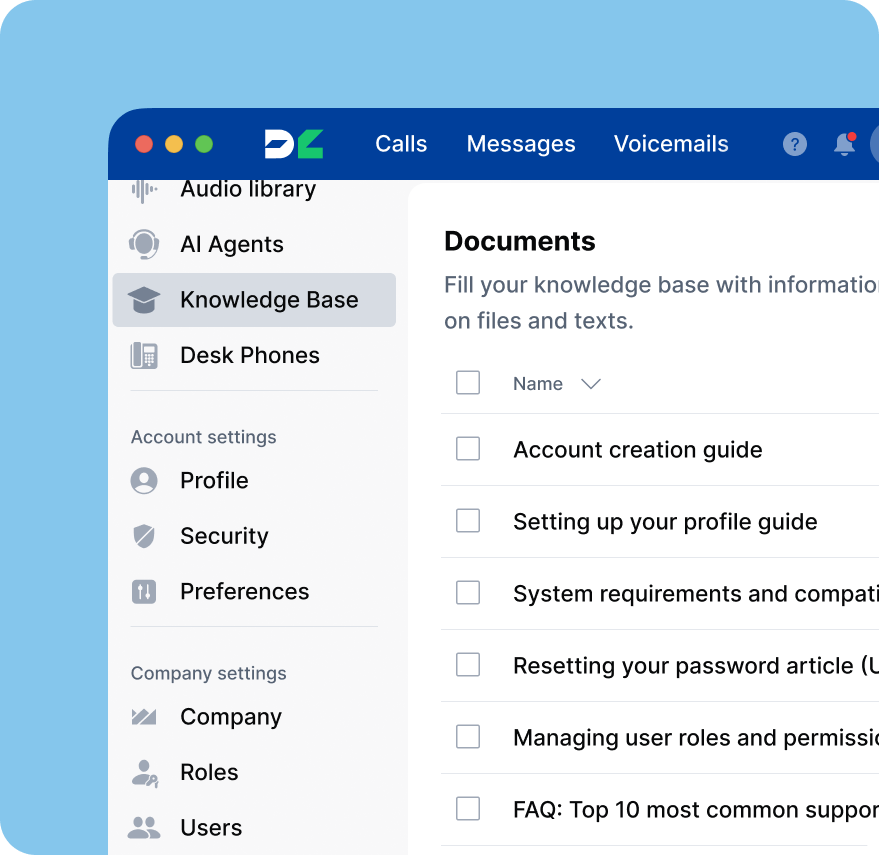
AI Voice Agent Integrations
To further connect AI voice agents to your internal workflows, you can seamlessly integrate them with the business tools you already use, such as CRMs, customer support platforms, eCommerce systems, and scheduling software, through DialLink’s MCP server.
This integration allows your systems to trigger AI voice agents to initiate calls based on predefined events, conduct conversations, capture key information during the call, and automatically update your tools or take actions as needed.
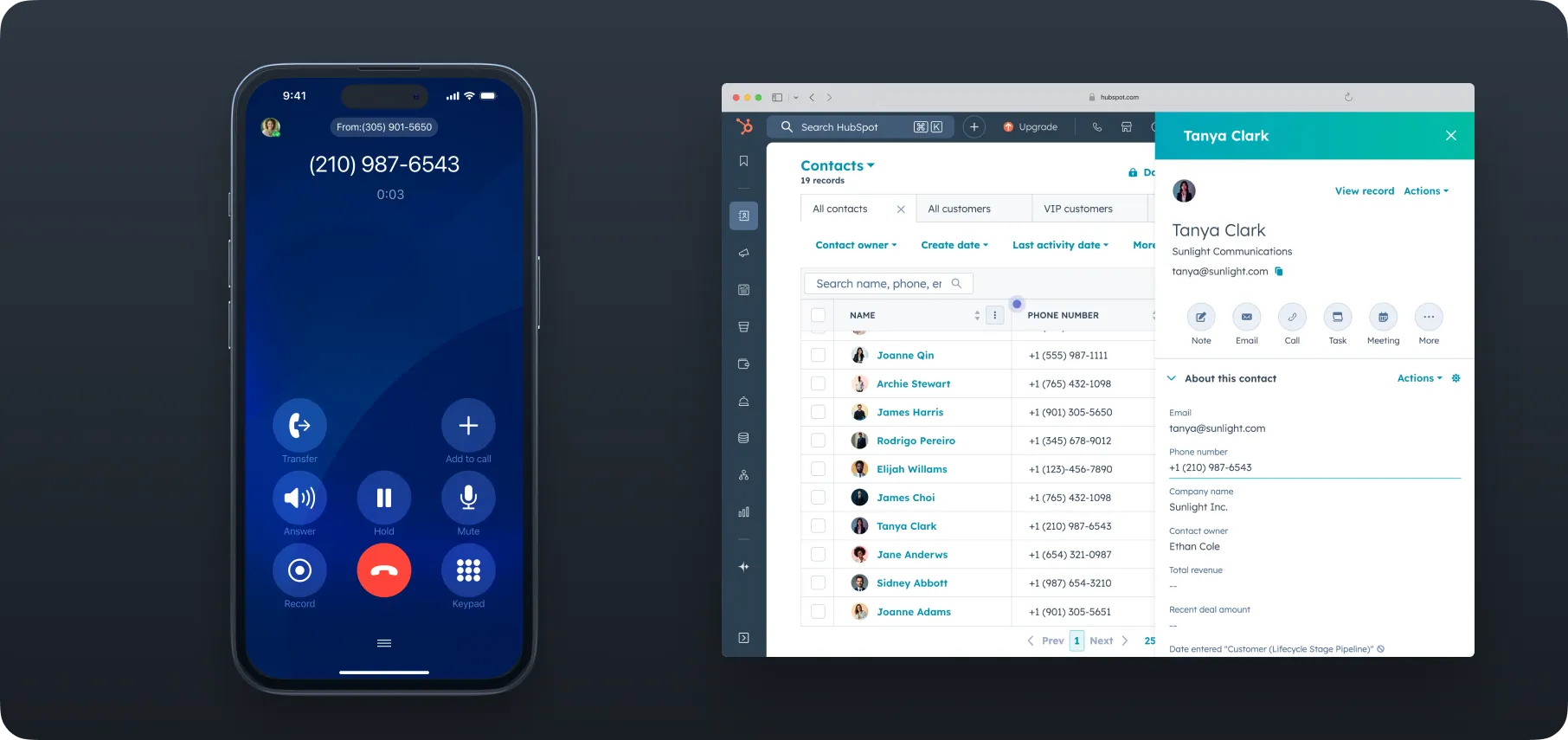
Related reading: Learn what MCP is, how it works, and why it’s revolutionizing AI voice agents, call automation, and integrations for SMBs and startups.
Omnichannel Communications
Today, outbound call centers that focus solely on phone calls may miss opportunities to reach a broader audience. Many customers prefer text messages or chat platforms, as they allow them to respond at a convenient time. In fact, how often does a conversation end with a prospect saying, “Call me later”? Limiting outreach to a single channel can reduce engagement and slow down your results.
DialLink unifies phone calls, text messages, and WhatsApp conversations within a single platform, enabling agents to communicate across channels without switching apps. Additionally, you can send interactive RCS messages featuring rich images, clear CTAs, and engaging offers, making it easier for customers to respond and interact with your business.
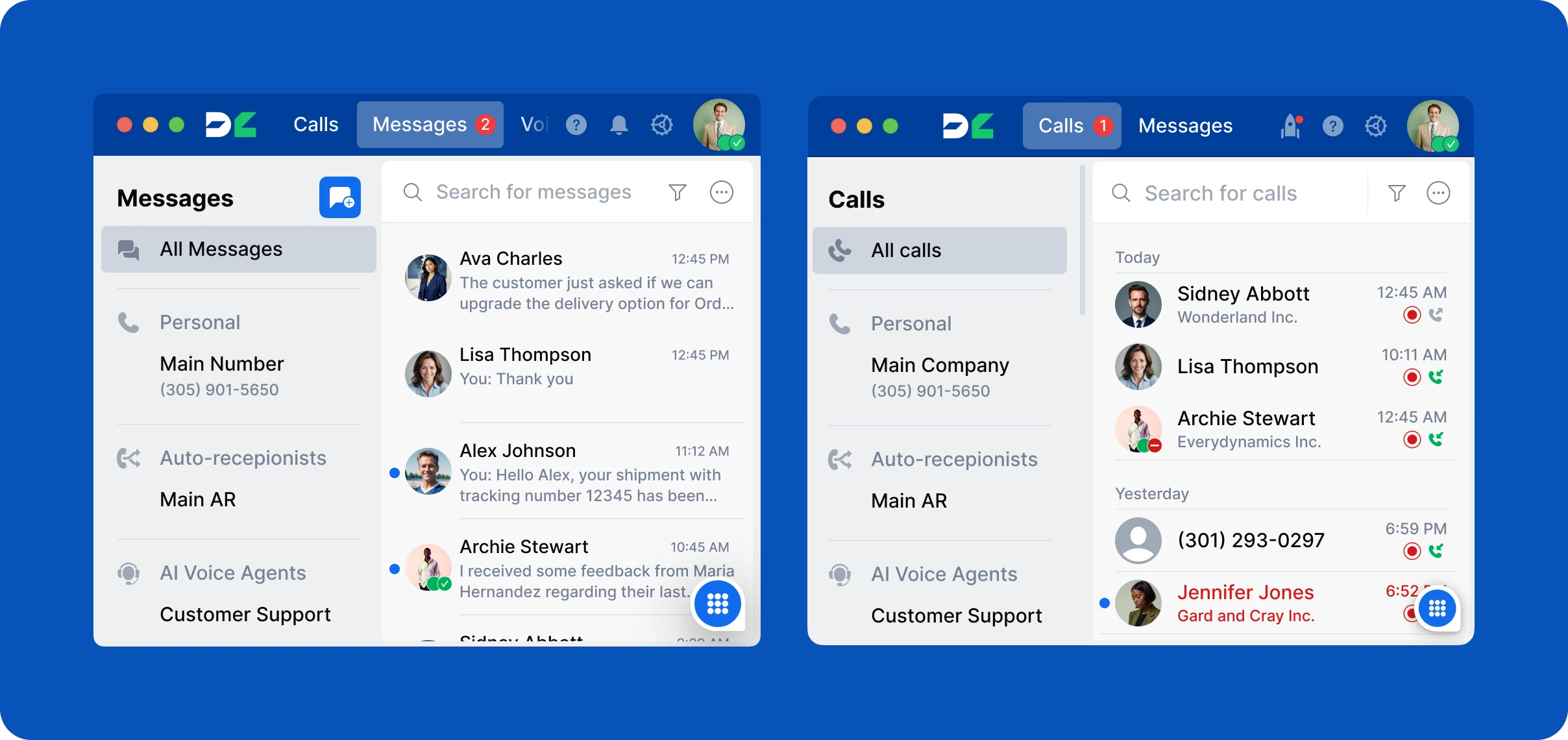
Device Flexibility
Last but not least, modern outbound call centers must be able to reach customers wherever they are, while giving agents the flexibility to work from any device. With a versatile platform like DialLink, your team can make and receive calls, send messages, and manage outreach from a web browser, mobile app, laptop, or desk phone. This flexibility ensures smooth operations whether agents are in the office, working remotely, or on the move, while maintaining consistent call quality, full access to customer data, and seamless workflow continuity across all devices.
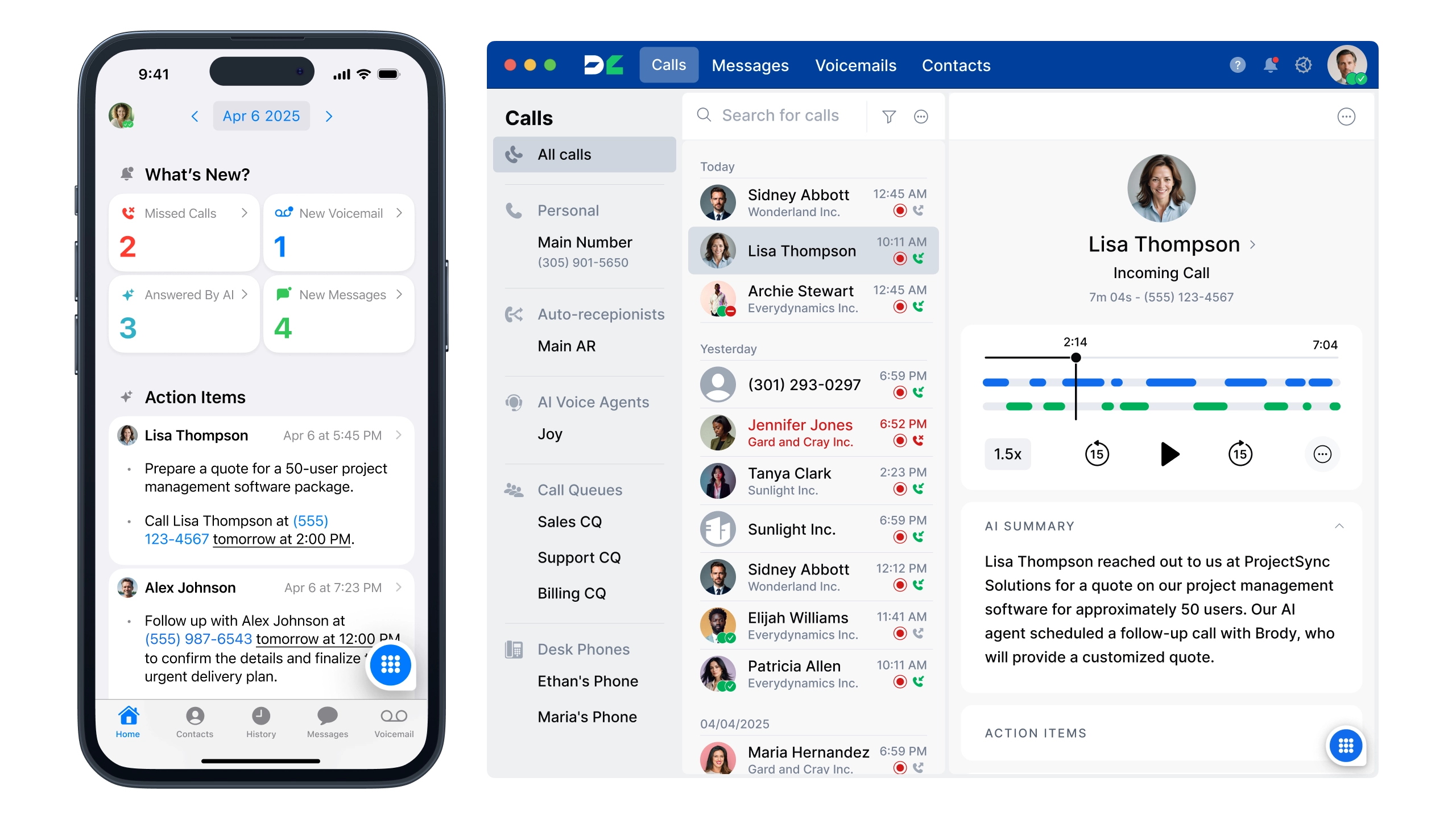
In-House vs. Outsourced Outbound Call Centers
When implementing an outbound call center strategy, small businesses face a key decision: manage it in-house or outsource to a specialized provider. Each approach has its advantages and trade-offs. In this section, will explore both options, along with the concept of outbound call center outsourcing:
In-House Outbound Call Center
Running an in-house operation means your business hires and trains agents (or uses existing staff), invests in an outbound call center solution and other software, and manages campaigns internally.
Pros: Full control over messaging, processes, and brand representation. Agents are dedicated to your business, and customer data stays in-house, which is important for privacy. You can closely monitor quality and make adjustments in real-time.
Cons: Resource-intensive, costs include salaries, training, software, and infrastructure. Ramp-up time can delay productivity, and managing a call center can divert attention from other business priorities. While an in-house setup can deliver high-quality and control, it requires significant time and financial investment.
Outsourced Outbound Call Center
Outsourcing involves hiring a third-party provider (often a BPO) to manage outbound calls on your behalf. You provide campaign goals, scripts, and criteria, while the vendor supplies agents, technology, and operational expertise.
Pros: Quick setup and scalability, with trained agents and dialer technology ready to go. Flexible staffing allows you to scale campaigns up or down efficiently. Cost-effective for small volumes, especially when using offshore centers, as you avoid overhead like full-time salaries or software investments.
Cons: Less direct control over day-to-day operations and brand representation. Quality management depends on clear communication with the vendor. Data security and customer information must be handled carefully. Customers may notice differences in agent familiarity, language, or accent, though reputable vendors mitigate this with training and oversight.
Before deciding which approach is best for your business, consider the following factors:
- Budget: Compare the predictable costs of outsourcing with the expenses of hiring, training, and managing an in-house team. For many small businesses, outsourcing is more cost-effective until call volumes reach a scale that justifies an internal setup.
- Expertise: If your team lacks experience running a call center, an outsourcing partner can provide the necessary knowledge and best practices. Conversely, if you already have skilled sales agents, leveraging them in-house may make more sense.
- Volume of calls: Low call volumes (e.g., 50 calls per week) may not justify a full call center, outsourcing or assigning part-time staff could be sufficient. High call volumes require an established process, whether in-house or outsourced, to ensure efficiency.
- Campaign complexity: Calls that require deep product knowledge or involve sensitive customer data are better handled in-house, where agents are fully familiar with nuances. Simpler tasks, like appointment setting or follow-ups, can be easily outsourced.
- Quality control: Consider how important direct supervision is. In-house teams allow for hands-on coaching and real-time feedback, while outsourcing relies on call monitoring and reporting, unless a close partnership is in place.
Conclusion
In this comprehensive guide, we explored what an outbound call center is and how it operates. In short, an outbound call center allows businesses to proactively reach customers and prospects via phone calls, typically for sales, marketing campaigns, or service follow-ups. By taking the initiative to connect, companies can drive more sales, gather valuable feedback, and strengthen customer relationships.
The success of your outbound call center, however, depends largely on the software and solutions you use. Modern call center platforms that follow best practices and provide performance tracking can significantly enhance the effectiveness of your efforts.
For small businesses, it’s also important to weigh costs and decide whether an in-house or outsourced approach is the best fit. While outsourcing can seem like a more cost-effective option, platforms like DialLink’s AI phone system, specifically designed for small businesses and startups, make managing outbound calls simple, affordable, and efficient. The platform offers quick implementation, requires minimal technical expertise, and delivers visible results from day one.
Try DialLink today for free and discover why it could be the best outbound call center solution for your business.
An outbound call center is a type of call center where agents proactively reach out to customers or prospects. Calls are typically made for sales, lead generation, appointment setting, customer follow-ups, or surveys.
- Inbound call center: Handles incoming calls from customers, such as support requests, inquiries, or complaints. The focus is on responding to customer needs.
- Outbound call center: Makes outgoing calls to customers or prospects for sales, marketing, follow-ups, or surveys. The focus is on initiating contact and driving specific outcomes.
The cost varies depending on whether you go in-house or outsource. In-house setups require expenses for hiring, training, software, phone systems, and infrastructure, which can range from a few thousand to tens of thousands of dollars depending on scale. Outsourced solutions often use a per-call or per-hour pricing model, making them more affordable for small volumes.
Modern AI phone systems like DialLink can reduce setup costs, offering quick implementation with minimal technical requirements.
The best solution depends on your business needs, but for small businesses and startups, modern cloud-based platforms like DialLink can be ideal. They combine call management, CRM integration, AI voice agents, and omnichannel messaging into a single platform. DialLink offers fast setup, minimal technical expertise requirements, and affordable pricing while enabling measurable results from day one.
Share this post
In this article
- What is an Outbound Call Center?
- Types of Outbound Call Centers
- What Is Difference Between Inbound and Outbound Call Center?
- How Does Outbound Call Center Work?
- The Importance of Outbound Call Centers for Small Business
- Outbound Call Center Key Performance Metrics (KPI)
- Common Challenges in Outbound Call Centers (and How to Overcome Them)
- Outbound Call Center Services and Solutions
- Beyond Traditional Calling: AI Outbound Contact Center
- In-House vs. Outsourced Outbound Call Centers
- Conclusion

Arina Khoziainova
Content Writer at DialLink
Arina is a content writer with over 7 years of experience in the IT industry. At DialLink, she creates clear, insightful content that helps small business and startup owners simplify communication and drive growth using modern tools. With a strong focus on practical value, Arina transforms complex topics into accessible, actionable stories.
Keep Reading

What Is a Virtual Phone Number and How to Get One for Your Business?
Learn what virtual phone numbers are, how they work, the types available, and how to get one for your business with DialLink.
August 27, 2025
17 minutes

Virtual Local Phone Numbers: Overview and Benefits
Explore everything you need to know about virtual local phone numbers to help you choose the right one for your business.
December 13, 2025
7 minutes

Local Vanity Phone Numbers for Business: What They Are and How to Get One
Read about what a vanity local phone number is, how businesses use them, and how to get one for your company.
December 12, 2025
8 minutes

How to Get a Local Phone Number for Your Business
Learn how to check local phone number availability, choose the right one, and purchase it for your business with DialLink.
December 10, 2025
7 minutes